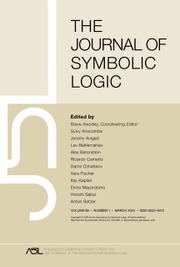Article contents
How enumeration reductibility yields extended Harrington non-splitting
Published online by Cambridge University Press: 12 March 2014
Extract
§1. Introduction. Sacks [16] showed that every computably enumerable (c.e.) degree > 0 has a c.e. splitting. Hence, relativising, every c.e. degree has a Δ2 splitting above each proper predecessor (by ‘splitting’ we understand ‘nontrivial splitting’). Arslanov [1] showed that 0′ has a d.c.e. splitting above each c.e. a < 0′. On the other hand, Lachlan [11] proved the existence of a c.e. a < 0 which has no c.e. splitting above some proper c.e. predecessor, and Harrington [10] showed that one could take a = 0′. Splitting and nonsplitting techniques have had a number of consequences for definability and elementary equivalence in the degrees below 0′.
Heterogeneous splittings are best considered in the context of cupping and non-cupping. Posner and Robinson [15] showed that every nonzero Δ2 degree can be nontrivially cupped to 0′, and Arslanov [1] showed that every c.e. degree > 0 can be d.c.e. cupped to 0′ (and hence since every d.c.e., or even n-c.e., degree has a nonzero c.e. predecessor, every n-c.e. degree > 0 is d.c.e. cuppable). Cooper [4] and Yates (see Miller [13]) showed the existence of degrees noncuppable in the c.e. degrees. Moreover, the search for relative cupping results was drastically limited by Cooper [5], and Slaman and Steel [17] (see also Downey [9]), who showed that there is a nonzero c.e. degree a below which even Δ2 cupping of c.e. degrees fails.
We prove below what appears to be the strongest possible of such nonsplitting and noncupping results.
Information
- Type
- Research Article
- Information
- Copyright
- Copyright © Association for Symbolic Logic 2008
References
REFERENCES
- 7
- Cited by

